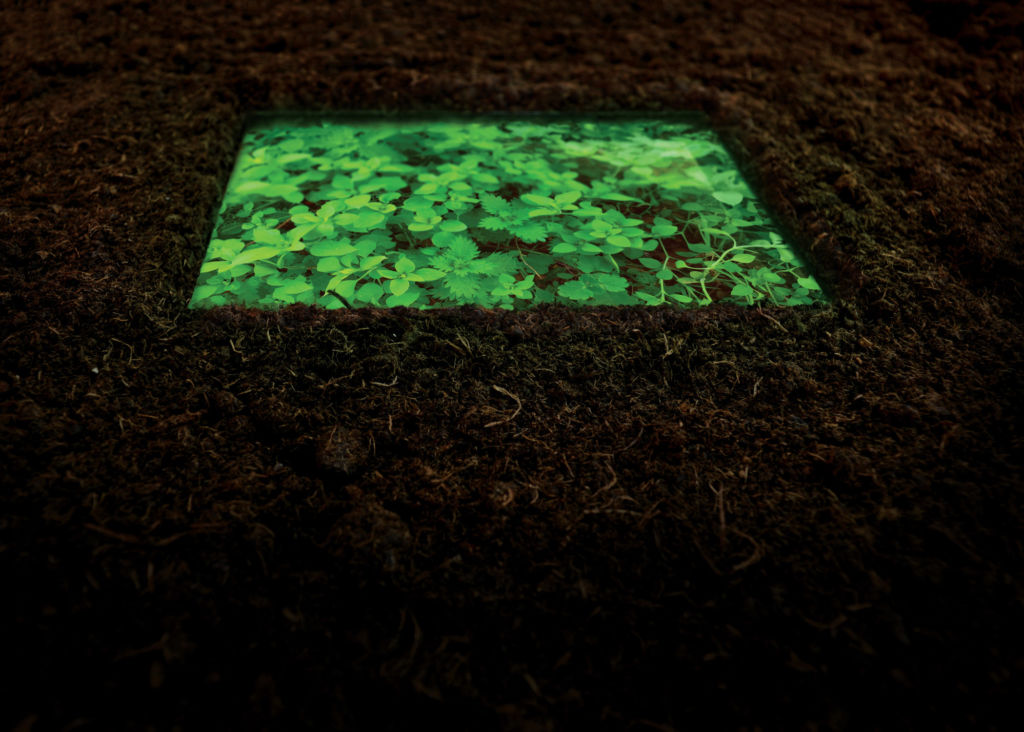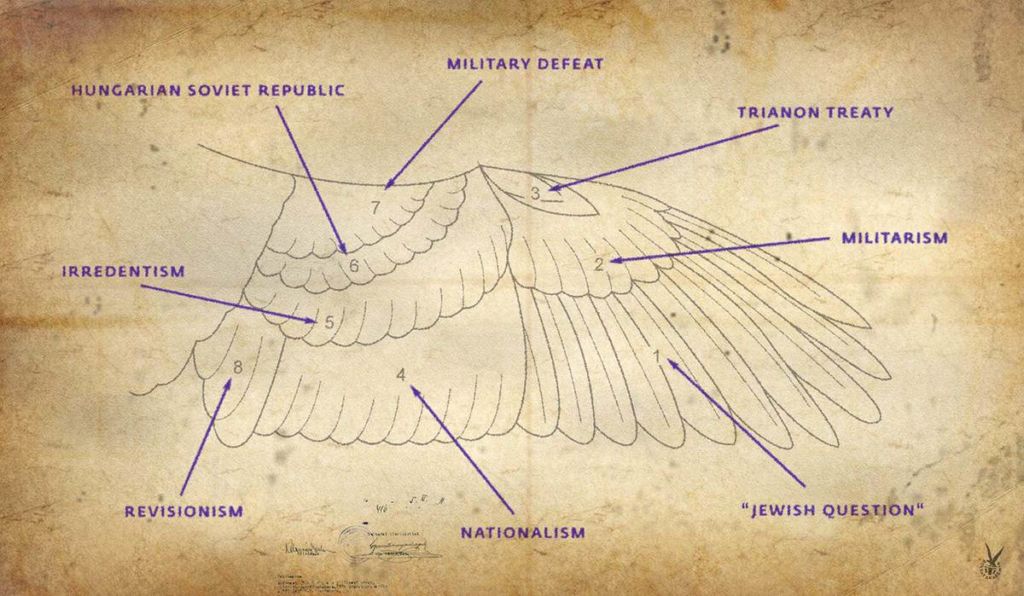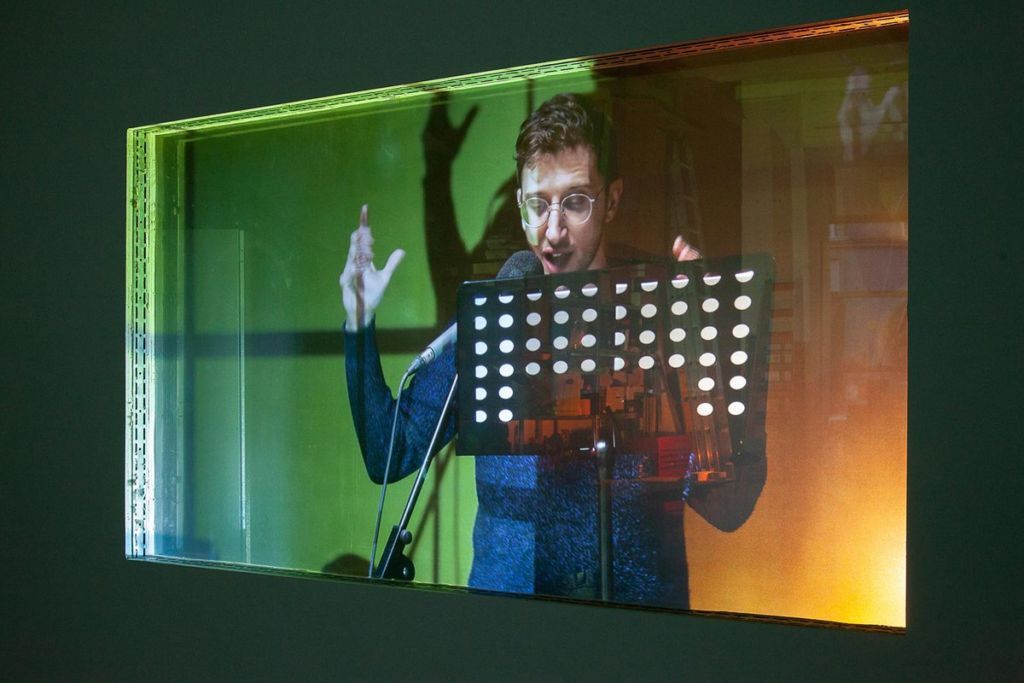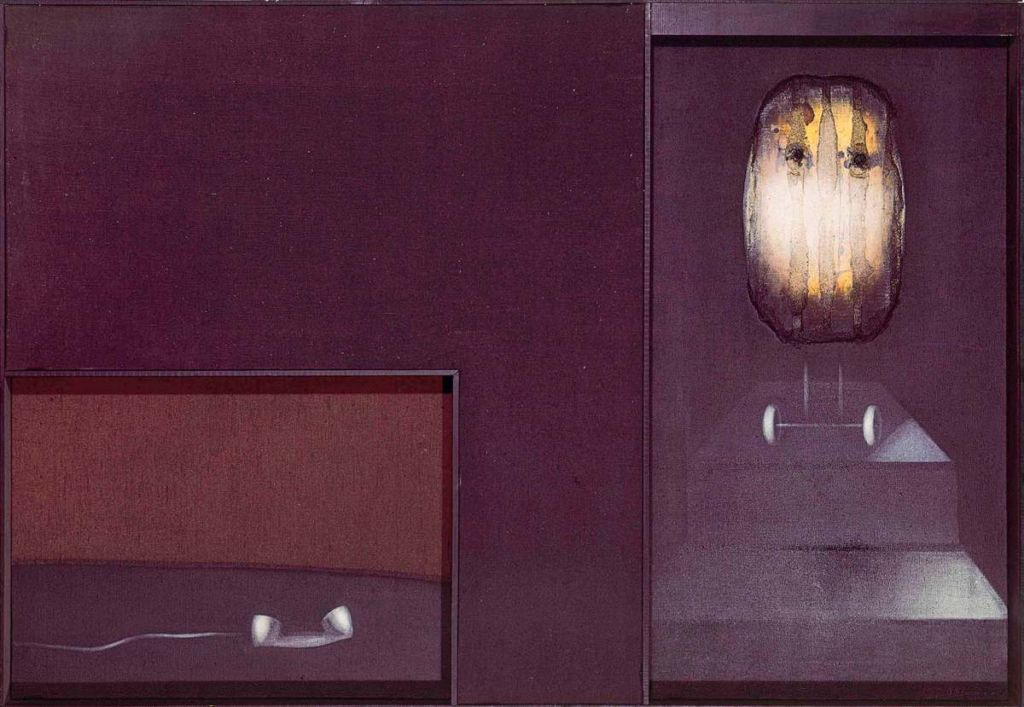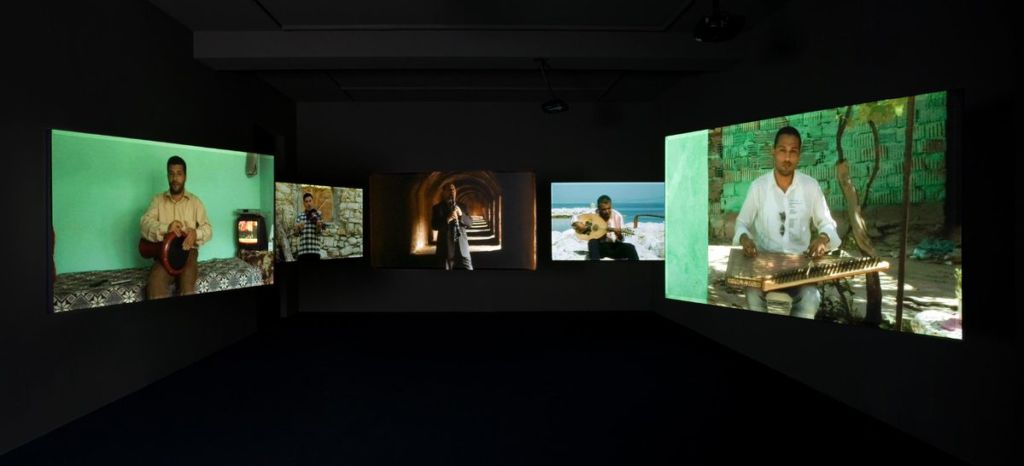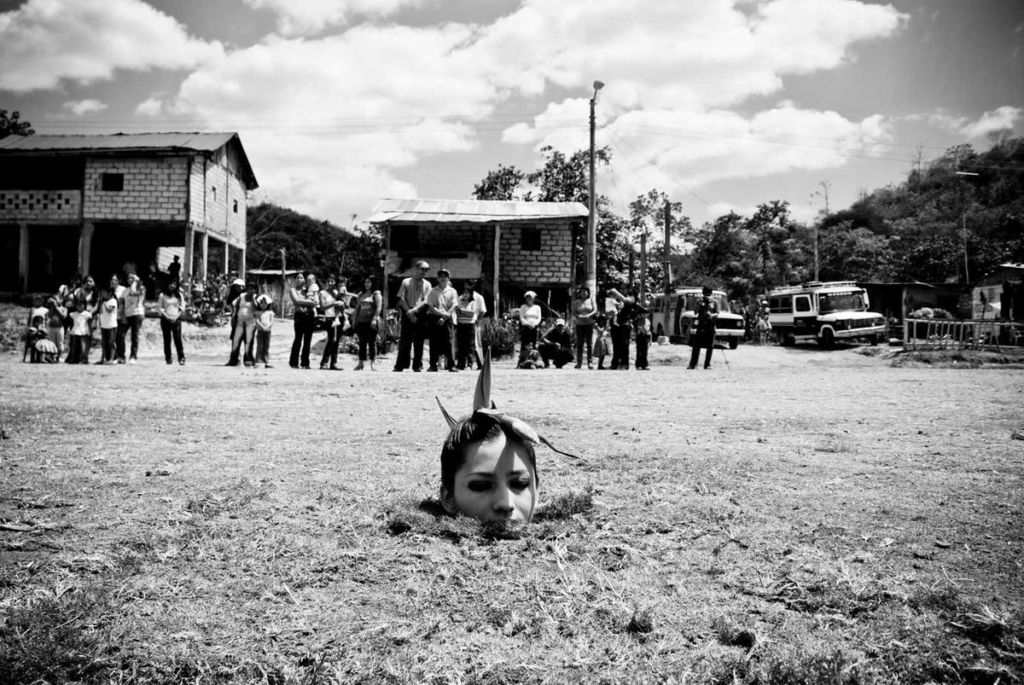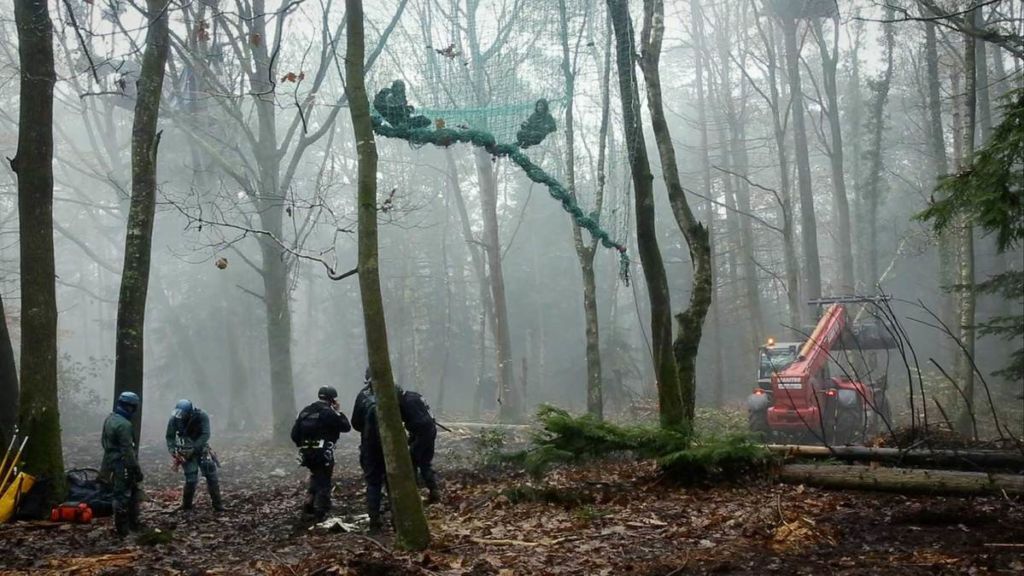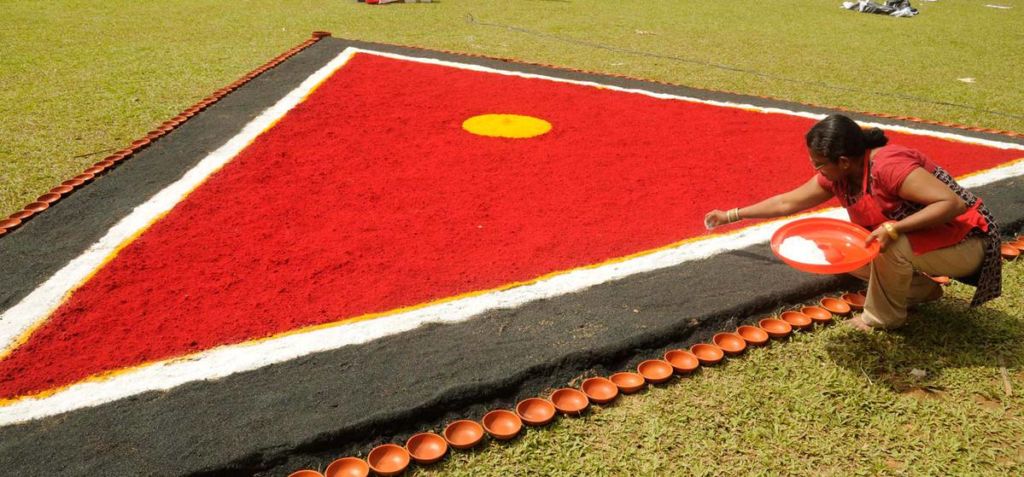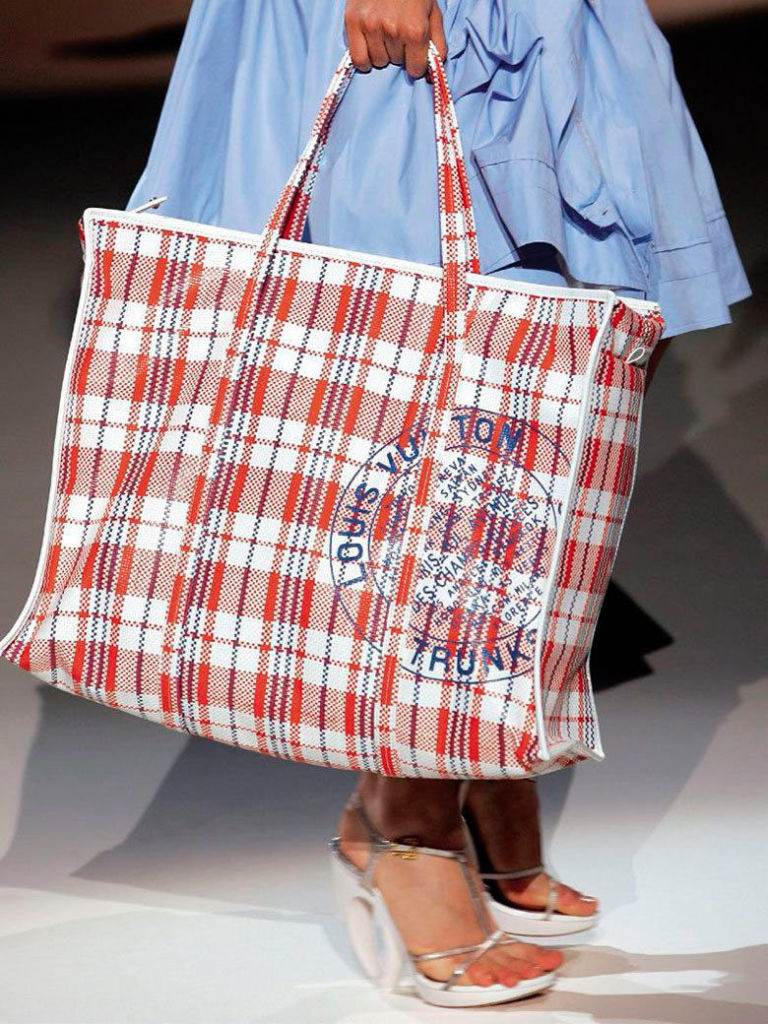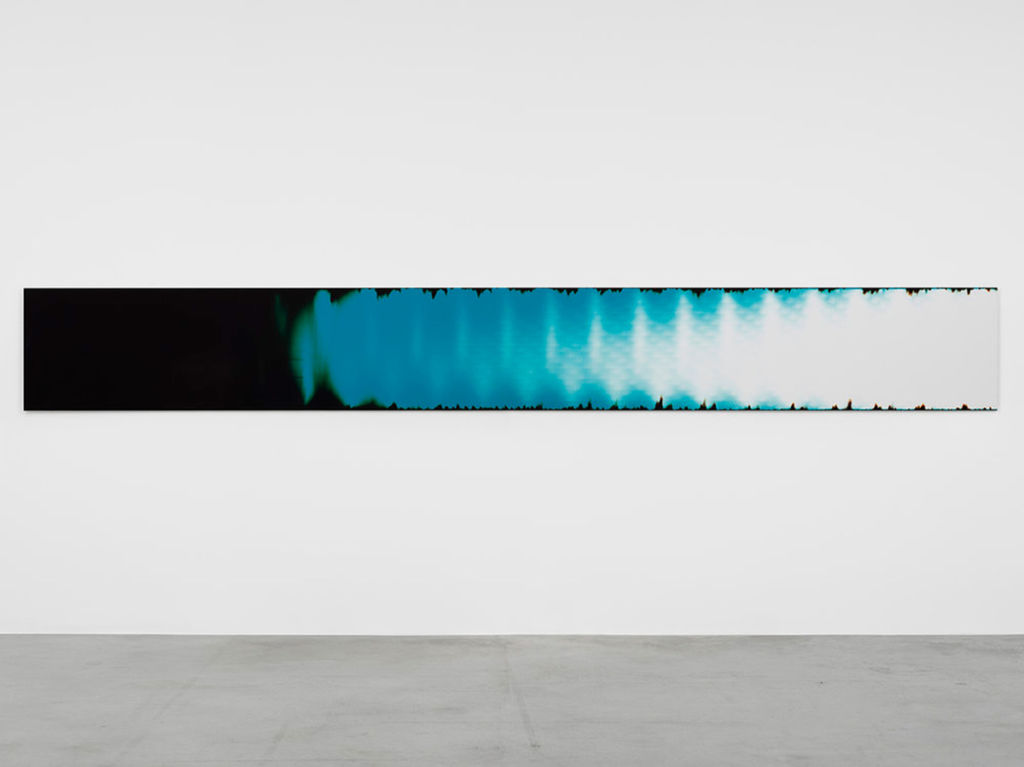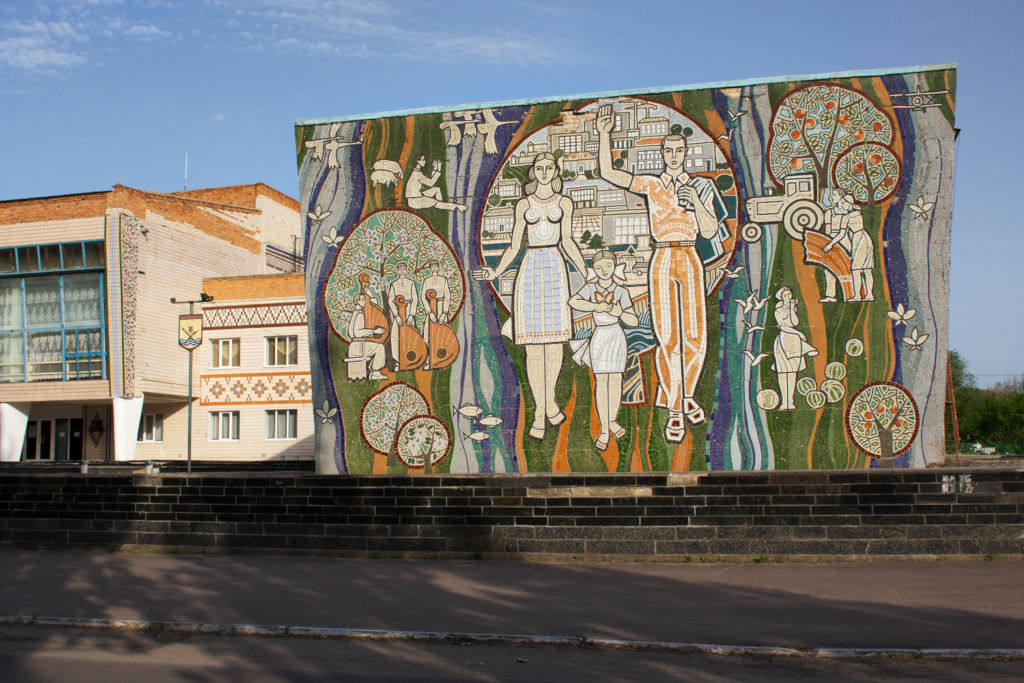Since the 1960s, artists have been concerned with environmental issues. Much has happened in the last sixty years: the ecological needs pointed out by the artists have become concrete, today’s new generation develop their own relationship with ecology and the environment.
Texte disponible uniquement en anglais
The 16th Istanbul Biennial, titled The Seventh Continent, in reference to the 3.4 million square kilometres, 7 million tons of floating plastic in the Pacific Ocean, took place from 14 September to 10 November 2019. Curated by Nicolas Bourriaud.
All the artists’ quotes in that text come from online conversations between the artists and the author and from statements written by the artists.
Gökçe Erhan (born 1983 in Trabzon, Turkey) lives and works in Trabzon. She graduated as valedictorian from the painting department of Mimar Sinan University, Istanbul, and received the Sakıp Sabancı Art Award in 2011. Among her solo shows are: İçimde Evler Yıkılıyor, TRAB-Rİ-KAB Garbage Disposal Plant, 2017, and Ballad of Shame, Pilot Gallery, Istanbul, 2013. She enacted several performances: in 2014, with Gülçin Aksoy, Group and Solo Songs, DEPO, Istanbul; in 2011, with Atıl Kunst, Garip Bir Pandik-1, MSGSU, Istanbul; and the same year, with Hazavuzu, Garip Bir Pandik-2, Rumeli Han, Istanbul.
Kerem Ozan Bayraktar (born 1984 in Istanbul, Turkey) lives and works in Istanbul. In 2019, he participated in the Berlin Senate Residency Program and the Istanbul Biennial Production and Research Programme. Previous to his latest solo exhibition Rocks and Winds, Germs and Words, Sanatorium, Istanbul, 2019, he had had six solo shows and participated in seventeen group shows.
Ozan Atalan (born 1985 in Gelibolu, Turkey) lives and works between Izmir and Istanbul. He studied law between 2003 and 2007 at Anadolu University Faculty of Law. In 2008, Ozan began his art practice at the Dokuz Eylul University School of Fine Arts Sculpture Department, Izmir. He earned his BFA in 2013 and was granted a Fulbright Scholarship for the MFA Program at Syracuse University, New York, where he earned his Master of Fine Arts degree in 2016. Currently, he is teaching in two Turkish universities and is doing a PhD in Arts at Yasar University School of Art and Design. Ozan’s work has been exhibited in both nationally and internationally esteemed venues such as the 16th Istanbul Biennial, 2019, or the 5th Moscow International Biennale for Young Art, Trekhgornaya Manufaktura, Moscow, 2020.
Huri Kiriş (born 1980, in Istanbul, Turkey) lives and works between London and Istanbul. She earned her Bachelor’s and Master’s degrees from the Institute of Social Sciences of Mimar Sinan Fine Arts University, Istanbul. She has continued DFA in the Fine Arts Institute of MSGSU, Istanbul. She is currently working as an associate professor in MSGSU Painting Department.
Deniz Çobankent (born 1976 in Ağrı, Turkey) is a sculpture and mixed media artist living in Istanbul. Çobankent tells the transformation of the city and the people in a figurative language with collected city materials.
Ayşen Savcı (born 1960, in Ankara, Turkey) has graduated from North Carolina Agricultural and Technical State University, Department of Industrial Engineering, in Greensboro, USA. She received her postgraduate degree in 1992 from Luleå University of Technology, Department of Production Economics, in Sweden. After she carried out a professional work life including several executive roles both in Turkey and Sweden, she has started to work on enamel and glass art. She has had seven solo exhibitions, participated in over ten group shows and one biennial.
Having been persistent subjects in Western art for over half a century, issues of environment and ecology mustered enough strength to secure themselves a place in the art world and create movements such as Land Art, Earth Art, Environmental Art and Ecological Art. Hans Haacke, Joseph Beuys, Carl Andre, Nancy Holt, and many others, added new perspectives to their various means of artistic production while issuing warnings, through metaphors and satire, about the damage inflicted unto nature by humans. Today, the environmental problems, much like the manifestation of a bad omen, surround us and, naturally, affect art production.
At this point, it is hardly coincidental that the 16th Istanbul Biennial is discussing the Anthropocene in its Seventh Continent.1 Recent environmental disasters we have confronted seem to confirm what the biennial underlines. But throughout the years, has art managed to raise awareness regarding our relationship with nature? Have artists had such a mission? Should they? While seeking answers to these questions, this article will refer to numerous short interviews with and statements by Turkish artists,2 alongside examples of their productions and their perspectives.
A Fairytale Hero in the Midst of a Habitat
Gökçe Erhan,3 activist and artist, has instilled a mission into her relationship with nature and production. Having chosen to move from the city to the country and hoping to transform her region into an ecological village, she notes that she may collate her artistic existence into a totality.
In 2008, she first began to discuss these thoughts in her series, Plastic Values, consisting of receipts, lottery tickets and discontinued banknotes made out of nylon bags. The decision to return to Çamburnu, her childhood village, allowed Erhan to work in a new direction, reimagining institutional exhibition spaces in nature. During the performance, Signature Day (2018), she gathered signatures from the local villagers in order to raise awareness of the nearby solid waste facility. By opening her Houses Razed Inside Me (2017) at a waste collection area, she managed to further emphasise the environmental problems in Çamburnu.
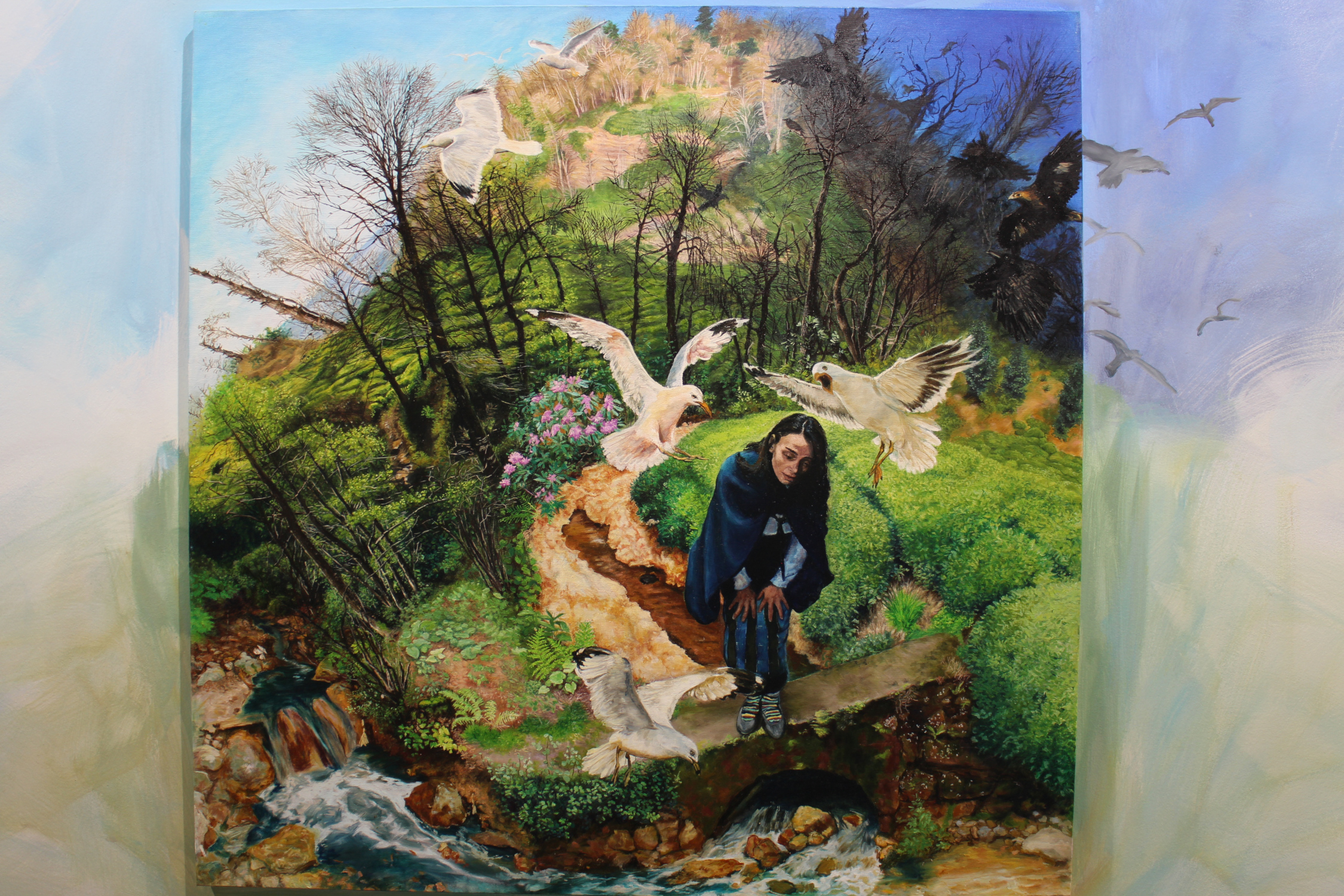
Commenting that artistic production should overcome aesthetic and conceptual concerns and assume a vital dimension, Erhan stands amongst the artists who seek sincerity in their relationship with nature. In a discussion on the intentions of artists taking up nature as an issue and to what ecosystem they belong, she asked the following questions: “What does the artist do with the revenue of their work on nature? Do they truly care about the ecological problems or are they merely donning an attire of exposure like a fashionable but transient trend?”
Erhan’s life and mode of production with nature have transformed, in her words, “into a quest for an actual solution within the aesthetic.” She defines herself as the protagonist of a fairy tale, who depicts her own authentic world. In her latest exhibition, Habitat (2018), she surrounds the spectator with panoramic natural landscapes to holistically approach problems of nature.
Nature and Ecology Transformed into a Method to Understand Life
Unlike Erhan, Kerem Ozan Bayraktar4 views nature as an observatory field where principles of universal physics and ecology can be understood as a method for investigation and creation. Having worked extensively on systems theory, the artist tries to apply ecology as a wholly analytic, holistic and complex manner of apprehension of the environment in all fields.
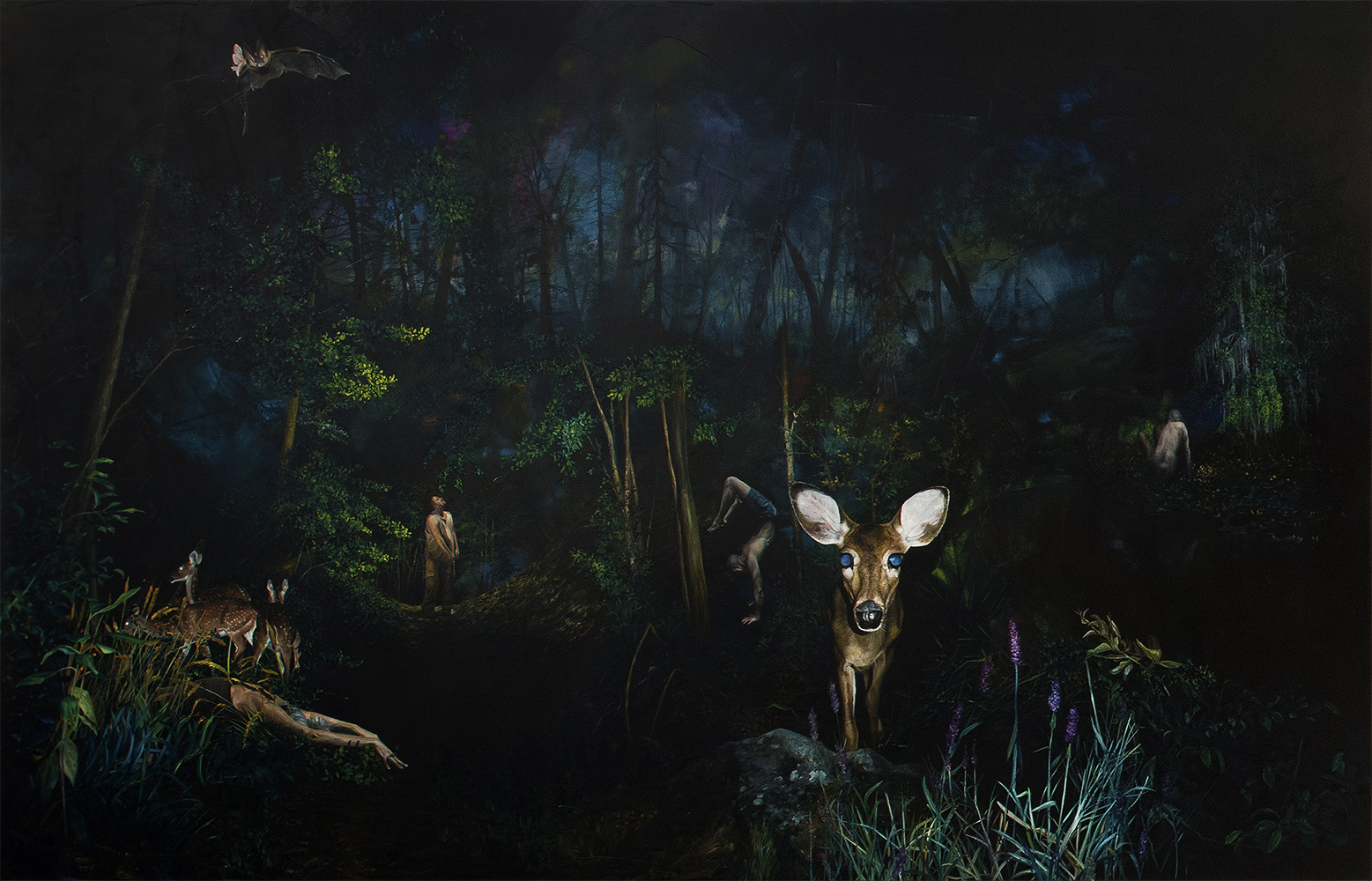
Huri Kiris, A day in Hell, oil on canvas, 2016, 150 x 165 cm
He approaches the environment as the clusters of relations any being builds with the outside world. In his latest exhibition, Rocks and Winds, Microbes and Words (2019), Bayraktar grapples with the relationship between animate and inanimate beings through matter and energy. He has adopted the premise that all objects differ in their terms of organisational context, despite adhering to the same relations of matter and energy—a view he demonstrates in his work Respiration (2019). The installation, consisting of iron pieces left in the water to rust during the exhibition, focuses on questions such as the transformation of inorganic matters and their ways of being affected, as well as relations of inanimate beings to animateness, motion, and variation. According to the artist, oxygen respiration and metal oxidation are somehow related; first living beings were in the water, just like these iron pieces. So are those metal cubes really inanimate?
Bayraktar has for some time worked on invasive plants found growing across the city and documented the process in photographs that were recently shown in Istanbul Biennial Public Activity Programme. In his manifesto, the artist emphasised that, contrary to the cliché of “nature resisting the city,” these are aggressive plants that are adapted to grow in areas of disrepair and benefit from human activity. In this alternative to attempts by artists to romanticise nature, Bayraktar summarises his views as follows:
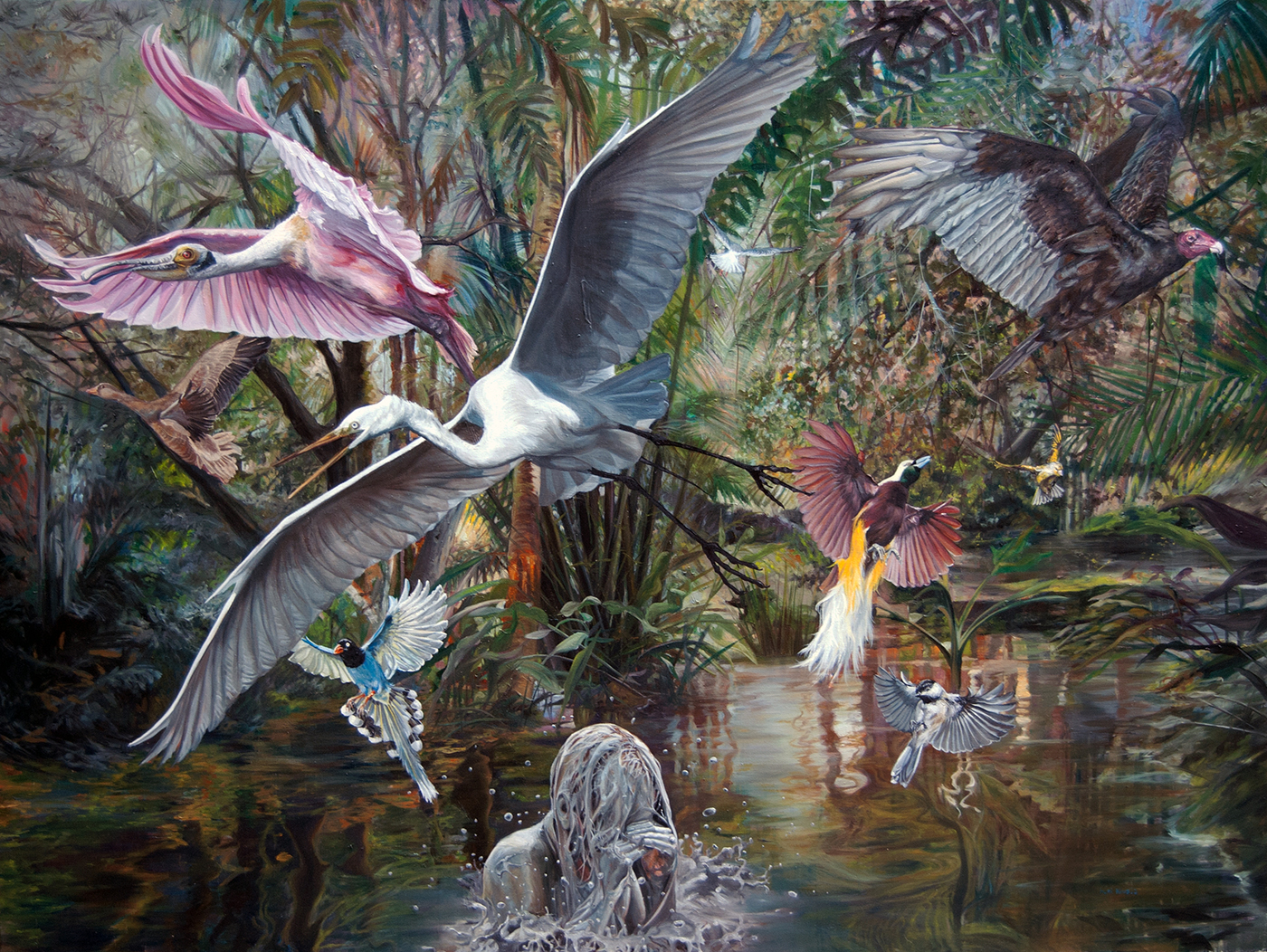
Huri Kiris, A day in Paradise, oil on canvas, 2013, 150 x 200 cm
“Nature is a concept created by humans and it’s uncertain where its boundaries begin and end. For instance, we do not protect invasive species, we eradicate them and nobody has an ethical response to that. There is an undisclosed idea of sustainability that is taken for granted. Nature is a dynamic network of relations also consisting of destruction and carnage: it has no Edenic form, it cannot be predicted or foreseen. We too are in it and we act as parasites. We will probably destroy ourselves, as well as many other species, but nature will survive. Therefore, it is relative to what manner of awareness we’ll gain through which perspective.”
The Ironic Conflict Between Intentions and Actions
When asked if environmental problems are exaggerated, the response by Ozan Atalan5 seems to share Bayraktar’s view:
“This is a debate that dates back to the advent of the modern environmentalist movement in the 1960s. While Rachel Carson could manage to raise awareness with her books, Björn Lomborg counter-argued that the world was better than it had ever been. There may be exaggerated cases, but this does not mean that there’s an environmental problem. This is a matter that depends on one’s mindset. You may be able to transform a particular behaviour to create a mass movement, but, in the long-term, the very same behaviour would manifest under a different condition. For instance, while the use of plastics was protested in Great Britain, venues that did not stock plastic drinking straws ironically began to use plastic bottles. In short, environmental awareness is similar to this; it urges to think over.”
Atalan does not distinguish nature from humans in his art production. Basing his approach on the primitive subjectivity, society, global culture and social reality that influence him, the artist creates holistic works that combine these components.
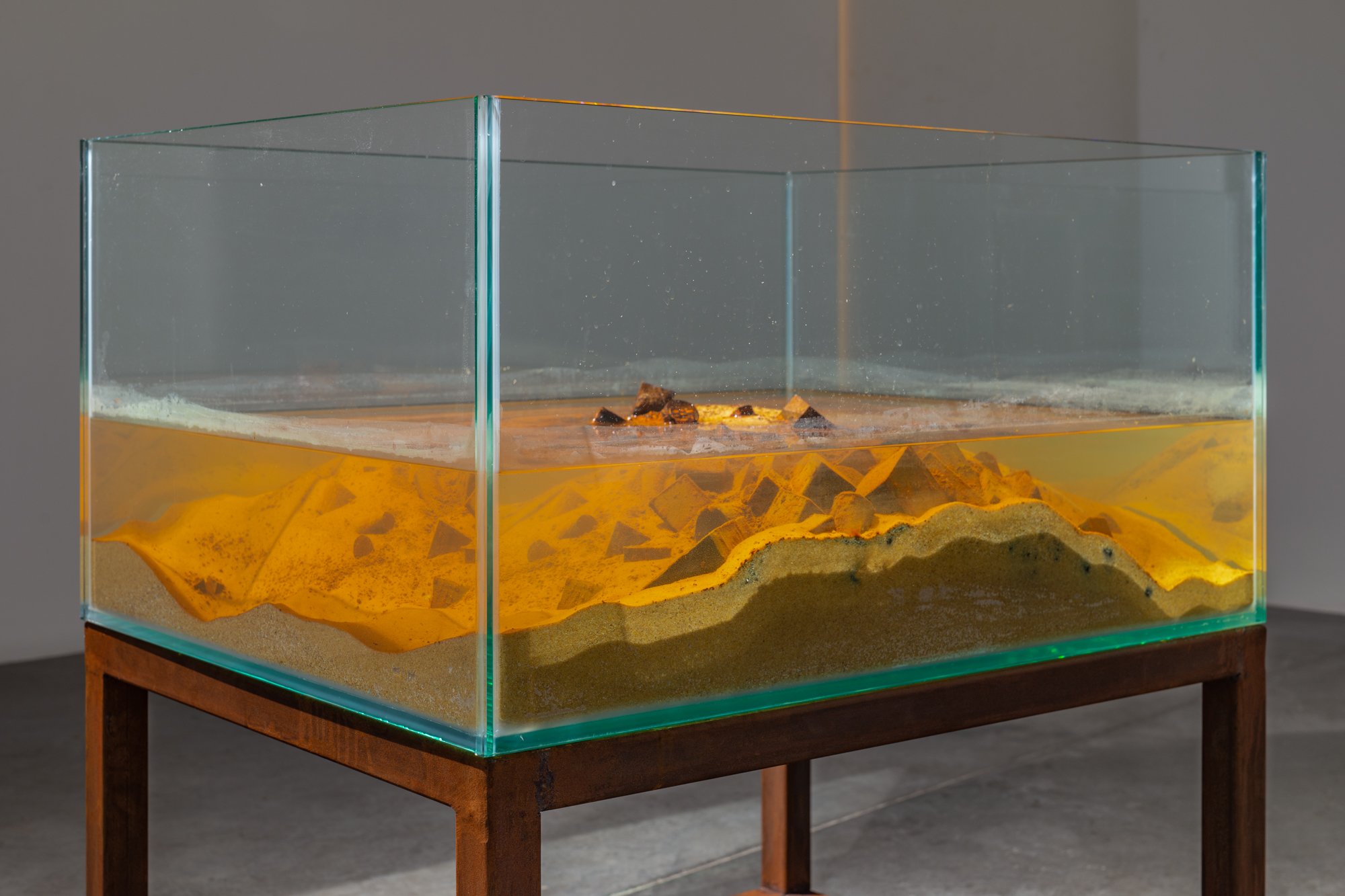
Kerem Ozan Barayktar, Respiration, 2019, 40 x 80 x 60 cm, sand, water and iron.
In his video installation, Nelipot (2019), featuring screens buried in soil, he interprets the pace of progress in the digital age as one of blind and groping advancement and criticises its uncanny nature. In his work Monochrome (2019), displayed at the Istanbul Biennial, he confronts us with a horrifying reality exposing a genuine ox skeleton, stuck in a concrete slab, and transformed into a monumentalised modernist aesthetic form in our social memory. The work underlines the danger of extinction of the oxen and other species in the northern forests of Istanbul in the wake of various construction works in the region.
Individual Enlightenment Subsequent to Social Enlightenment
Meanwhile, Turkish artist Huri Kiriş’s6 works can be described as “a perfect apocalypse,” featuring diligently detailed paintings and drawings of utopian and dystopian landscapes bordering on hyperrealism. Like many artists, she takes a holistic view of nature, environment and ecology, outlining her approach as follows:
“When I take up humans as a subject, I also take up nature, and vice versa. My awareness of this peaked during the Gezi Park protest, before which I used to turn to painting as a refuge from a feeling of congestion. Ultimately, I started painting a scene where five women running nude into a dark forest past an overturned, burning car. All of a sudden, the protests erupted and the painting was left unfinished. As many public properties were damaged during the protests, there was a concomitant talk about trees and nature. As everyone was talking about returning to nature, I ended up going through my unfinished works. There was communal orchard being set up, calls were going up in response to this malady we were trying to rid ourselves off of. All this truly set me to think. My women were running, but where to? What was in those dark woods? Was salvation truly ‘there’? Do we know ‘there’? What awaits us? Besides, where did this salvation come from? Weren’t we supposed to mechanise and achieve welfare?”
The artist, whose relationship with nature became clear after the Gezi Park protests, proposes a new depiction of it in her works, where wildlife, distinct landscapes and climates are conjoined. Attempting to discern the distance between humans and what they call nature, Kiriş interprets this relationship as a collection of political acts. She argues that since we have been evolving within nature and transforming it sporadically in order to raise civilisations, the entirety of the humanity knowledge relies on it, adding:
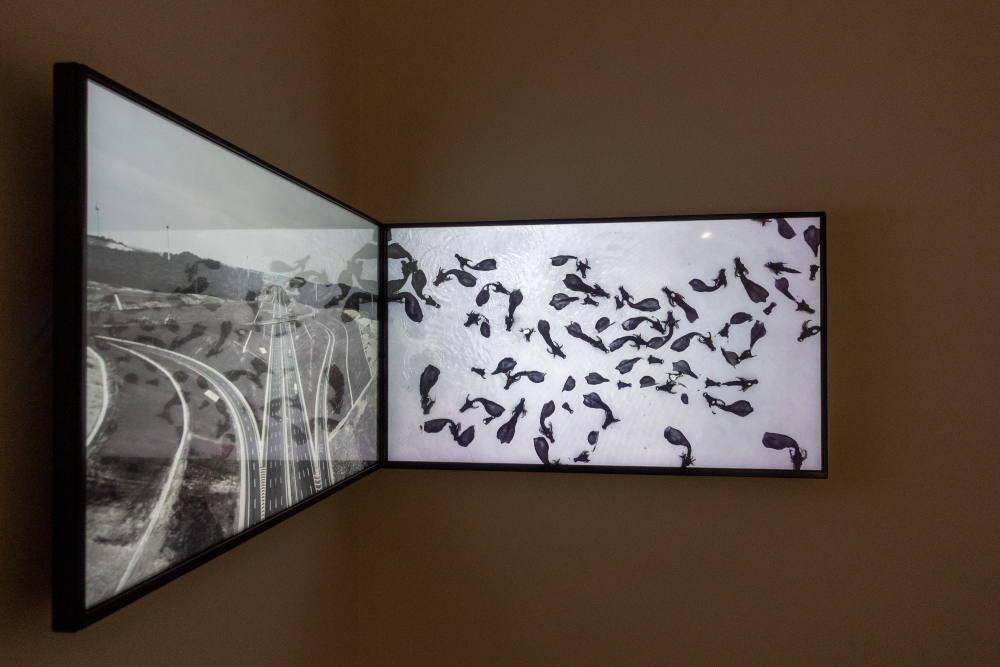
Ozan Atalan, Monochrome, 2019, installation, detail. Video: 10’. Courtesy the artist. Commissioned by the 16th Istanbul Biennial. Co-produced by the 16th Istanbul Biennial and MO.CO. Montpellier Contemporain with the support of SAHA–Supporting Contemporary Art from Turkey.
“We are ignorant about our own nature, as well as about that which we assume to be outside ourselves. With our limited knowledge, we are trying to dig ourselves out of yesterday’s utopia and today’s hell. And our conviction that the way out lies in ‘nature’ is unshakable. By anthropomorphising it, we believe it has emotions, that it actually loves us but sometimes warns us, that it chastises us or that it even avenges itself on us. In this fantastical despair, we are parts of one another. Albeit in different manners, all my works speak of this.”
Generations Born into an Environmental Crisis
Though the techniques or focuses of the artists presented in this article may differ, it’s fair to say that they all converge on the common denominator of their relationship to nature.
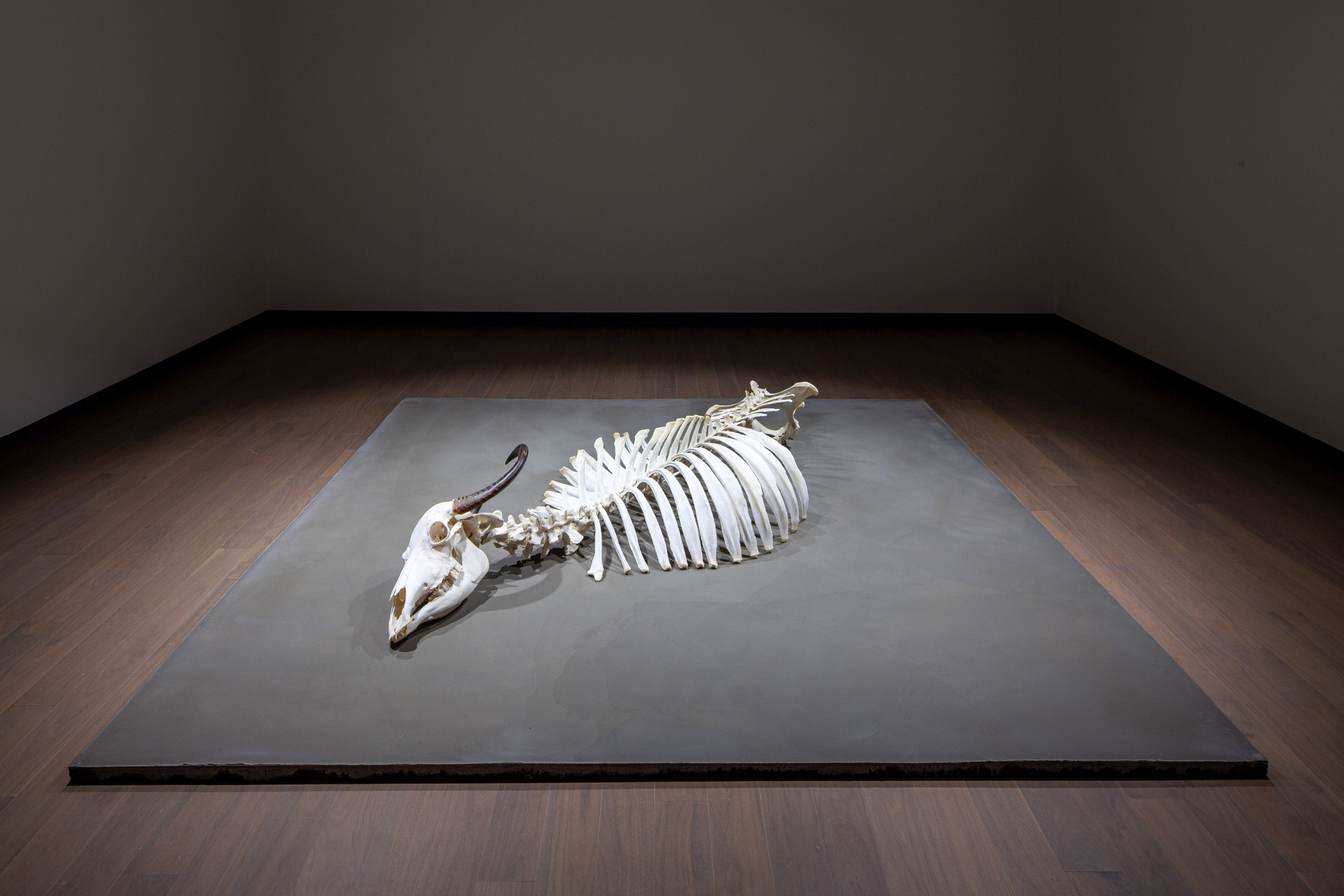
Ozan Atalan, Monochrome, 2019, installation (concrete, soil, video, water buffalo skeleton) 3 × 3 × 1 m. Video: 10’. Courtesy the artist. Commissioned by the 16th Istanbul Biennial. Co-produced by the 16th Istanbul Biennial and MO.CO. Montpellier Contemporain with the support of SAHA–Supporting Contemporary Art from Turkey.
One line of thought is that they may be the successors of the 1960s artists, who were nature protectors. Like Erhan, some artists believe that our relationship with nature should go beyond being merely the material necessities and have to be the reality of life. This approach, arguing that art possesses the power to underline the problems in our relation to nature, could be effective in creating solutions. But, of course, another dimension of the debate is whether art has such a mission.
Another issue is that many artists view nature and society as mutually inclusive structures. Not only as artists but also as individuals, they have come to identify their relationship with nature, as well as their role within it. They had to reckon with concepts of the city, profit, capital, society and nature, across the vast expanse of issues in the past sixty years. Nevertheless, it wouldn’t be unfair to say that they have a firm grasp of the literature built around these issues, or that they went through a lengthy period of contemplation on their own relationship with nature.
It appears that this awareness has reflected unto their works as an approach more akin to that of a scientist. As the artists define nature through their own perspectives, they reconsider the meanings that have come to be taken for granted and produce ground-breaking works. Therefore, they display a conservationist approach in their productions, yet this comes across as less of a romantic view than a rational one. While some artists lean towards unprecedented depictions of nature on their canvases, others employ mixed media, including such that consists of scientific methods. Some have come to see nature as a field of production and exposition, though in general, their works meet the viewers in institutional exhibition spaces.
Discomforting Truths
Can we observe a distinction between the ecologically minded artists of the 1960s and those of today in terms of their productive preferences? We may never be able to answer this adequately. After all, many works of art are the natural result of the intersection of the spontaneity of art and that of the daily realities of a given time. The pioneering ecological artists of the 1960s were dealing with the nascent environmental issues while they could already feel the spirit of budding 1970s in the air. The scarcity of the means of mass communication and the loud declaration of a scarcely discussed issue had made a huge difference then. Today, we are witnessing artists who work on nature but are also surrounded by environmental issues that have been almost mythologised into a cult of sensitivity, where thousands of voices rise in the name of environmental awareness.
We are all aware of ourselves as links in the consumer culture underneath the climate issues plaguing us. It is difficult to answer the question, whether known truths cause any change in the age of post-truth. The calls to “Vote green for change” do indeed expand alongside the 40-year-old discourse of Greenpeace, which is now embodied by Greta Thunberg. Though actions may differ, the problems underlined and warnings given continue to persist. For instance, Deniz Çobankent,7 when asked about the relationship between the city and society, answers that her generation is insulated from the issues of environmental awareness, noting that efforts to raise awareness end up in vain and that their own initiatives remain solely at the level of personal satisfaction. Ayşen Savcı8 expresses the difficulty to contemplate issues of nature, environment and ecology for those who are in a daily struggle for their lives and livelihoods. Stating that art can make a difference in raising awareness about environmental sensitivity, she adds that this doesn’t necessarily need to be through depicting defiled nature but by the effective use of an exciting aesthetic interpretation.
The arguments and works of the artists surveyed in this article demonstrate a new awareness regarding our relationship with nature; an awareness that averts clichés and breaks taboos, with no reticence to expose the insincerity of the repetitive works on nature. Though we forcefully face those dreaded dystopias of the past, we should bear in mind that the future of the environment will bear the mark of the arts as well. As we look towards the future, in terms of nature and environment, we can feel the approach of a brand new artistic view that evokes new examples in the spirit of the avant-garde productions of the 1960s and is capable of interpreting the hybrid realities of the new age.
Editor: Vincent Simon
Translation from Turkish to English: Emir Uslu
Cover: Ozan Atalan, Nelipot, 2019, video installation
